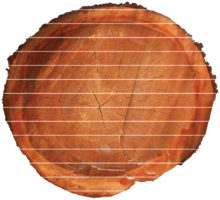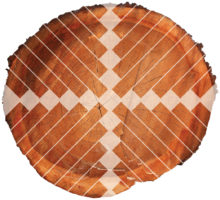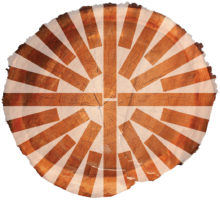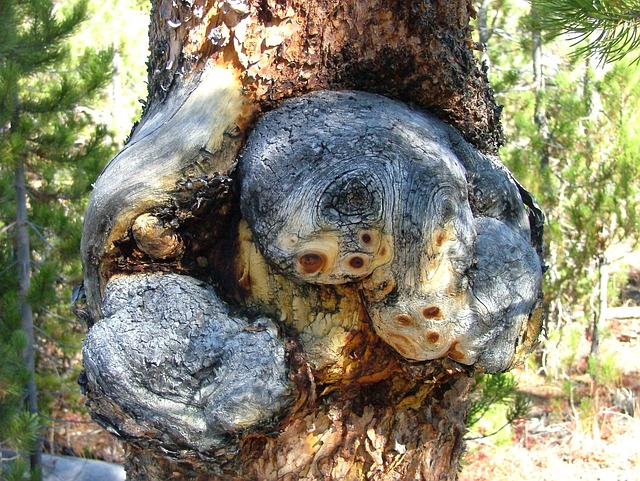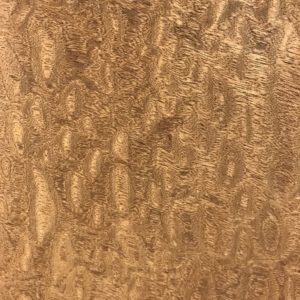You probably recall learning how counting the rings on a log will help determine the age of the tree it came from. These annual rings are what give planks of lumber the grain lines we associate with cut wood. The way wood is cut has a significant effect on its appearance, its structural integrity, and its price. Understanding the basic types of milling will help you to understand how these processes affect wood’s appearance, and will give you an idea of what professional woodworkers seek out when choosing lumber.
Plain-Sawn
Plain-sawing (or flat-sawing) lumber involves cutting planks parallel to the diameter of the log. Looking at the end of the plank, or endgrain, you will see long, curved grain lines parallel to its face. These are the log’s annual rings. These may appear compact or loose, depending on the species of tree and where in the log the plank was cut from. These rings appear on the face of the plank as dramatic swirls, often called “cathedrals” or “flames.”
Plain-sawing logs is the simplest milling process with the least amount of waste. It is therefore the least expensive. The downside, however, is that it is also the least dimensionally stable. Plain-sawn wood is more prone to warpage, such as cupping.
Quarter-Sawn
Quarter-sawing (or radial-sawing) lumber involves multiple steps. Exact methods vary from mill to mill, but generally, a log is first cut into quarters. These are then cut into planks at an angle of 60 to 90 degrees to the flat surfaces of the quartered log. Subsequent cuts produce increasingly narrower planks.
The endgrain lines of quarter-sawn lumber are nearly perpendicular to the face of the plank. This produces a much more dimensionally stable plank with greater resistance to warpage.
The process of quarter-sawing can also reveal the medullary rays – lines that extend from the center of the log perpendicular to the annual rings. The presence of ray flecking in quarter-sawn timber is often desirable, as it adds additional depth and character to the wood. Some species, such as red and white oak, display these characteristics more dramatically than others.
Quarter-sawing is more labor intensive and produces more waste than plain-sawing. This lumber therefore commands a higher price. Many woodworkers favor quarter-sawn lumber to plain-sawn, however, for its stability and its appearance.
Rift-Sawn
The last common type of milling is rift-sawing. This process is similar to quarter-sawing, but the angle of the cuts to the annual rings is narrower – between 30 and 60 degrees, with 45 degrees being ideal. Again, this angle is visible in the endgrain. The process of rift-sawing produces extremely stable planks with tight, uniform grain patterns.
Rift-sawn planks are often sought after for the uniformity and depth of their grain lines. The rift-sawing process, however, is also the most labor intensive and produces the most waste. As a result, it is often more difficult and more expensive to obtain rift-sawn lumber than either plain-sawn or quarter-sawn.
Rotary Cutting
An additional type of cutting – used primarily for making veneers – is rotary cutting. A log is placed on a machine similar to a lathe and then rotated. As it turns, a blade cuts a thin layer from the log. This slice of wood is then flattened. Veneers can also be produced by flat-sawing lumber, often with fetching results.
Additional Woodgrain Characteristics
Professional woodworkers pay careful attention to the character of woodgrain and often incorporate unique grain patterns into their designs. Here are several other characteristics and techniques they employ.
Burl Grain
One woodgrain characteristic prized by woodworkers is burl grain. Burls are knob-like growths that appear on the exterior of tree trunks, like stunted branches. The wood of burls is highly figured and is sought after for its unusual shape and for the unique and interesting patterns of its grains. It can be difficult to work, however, so is not necessarily desirable for all applications.
Mineral Streaks and Other Character Marks
Natural streaks of color can sometimes appear in woodgrain, often gray, rust, or olive. These are caused by mineral deposits in the soil surrounding the tree. These minerals build up inside the tree’s cells and cause streaking similar to the discoloration that sometimes occurs in sinks and bathtubs. While planks with these streaks are sometimes avoided by those striving for uniformity, many woodworkers seek out these natural variations for their unique character.
This is also true of wood with an abundance of knots and worm holes. Some woodworkers view these as imperfections, while others see them as character marks. Knotty planks with mineral streaks and tiny holes are often incorporated into rustic designs. This lumber carries the added advantage of being less expensive than clearer planks.
Birdseye, Quilted, and Curly Figuring
Sometimes lumber will display attractive figuring in distinct patterns. Some species, notably the soft maples, display these characteristics more dramatically than others. It is uncertain exactly what causes these patterns, though environmental factors are thought to play a role. Not until a tree is cut do these figures become evident. Common patterns include birdseye, quilted, and curly.
The term “birdseye” is used to describe wood figured with numerous tiny knots surrounded by loops of grain. These knots resemble the eyes of birds, hence the name. This figuring is most pronounced when flat-sawn.
Another sought-after – and expensive – pattern is quilted figuring. The term “quilting” is used to describe broad, wavy grain patterns that resemble cirrus clouds or, with some imagination, the squares of a quilt. Flat-sawing reveals these patterns most dramatically. The striped patterns of quilted maple are often seen on the bodies of electric guitars.
A third common type of pattern is curly figuring. Grainlines form crosshatched ripples, similar to quilting, but tighter, with more prominent vertical grains. Unlike birdseye and quilted lumber, this figuring becomes most pronounced when quarter-sawn.
Bookmatching
Finally, one popular technique for showing off the unique, natural character of woodgrain is called “bookmatching.” Two planks cut from the same log are placed side by side, with one plank flipped over to mirror the graining of the adjacent plank. The similar grain patterns create a very attractive symmetry. The effect is similar to patterns created by inkblots on folded paper.
Understanding the characteristics of woodgrain and how different methods of milling can expose and enhance these characteristics can help you better understand what to look for when choosing wood for your next project. As always, when questions arise, be sure to consult an experienced woodworking professional.

